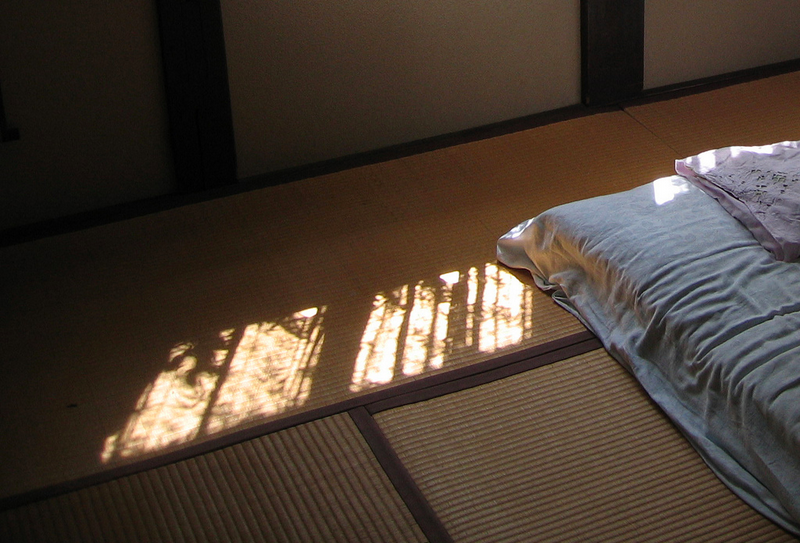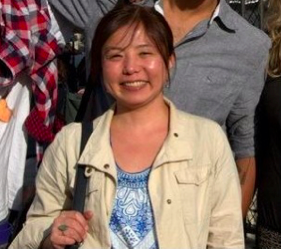Essay by Kaori Fujimoto
Between Two Languages, a Door Opens

When I was a child, the unfamiliar was my best friend. I longed to experience worlds far from my own quiet life in a Tokyo suburb, where my parents and much older siblings mostly left me alone. So, I read—especially the foreign books, translated into Japanese, that my mother bought me.
Those books included The Robber Hotzenplotz by Otfried Preussler, Fattypuffs and Thinifers by André Maurois, and volumes in Maurice Leblanc’s Arsène Lupin series. I kept them in a stack on my desk so I could carry them anywhere in the house. Propping my head on a floor cushion in the tatami-matted living room, I spent a night in a damp, cold German castle with the boy locked up there by Hotzenplotz. Burying my small frame in the big leather couch in my father’s study, I ambled through the beautiful Fontainebleau wood with the fat boy and his skinny brother—and then hopped with them onto the escalator leading to the underground world. Curled up in front of a space heater in my room, I watched horse chestnut leaves shimmering along the Champs Élysées while Lupin whispered his love for Paris.
In high school, I read my first book in English; in college, I ventured for the first time into a foreign bookstore in Ginza, one of Tokyo’s upscale districts. The small, dimly lit store was filled with the scent of unfamiliar paper—paper that was thicker, rougher, and slightly mustier than the paper Japanese publications used.
At home, I kept turning pages of the books I’d bought, such as The Ballad of the Sad Café and The Catcher in the Rye. I was fascinated by the way that simple words made up of letters in the Roman alphabet were spliced to evoke telling images of places I had never been. The black-and-white strings of letters conveyed the smell and temperature of the air in which the characters chattered and guffawed with their neighbors over a drink, got out of bed in the morning to find frost on their windowsills, or trudged in the evening rain through a maze of city streets.
• • •
As I grew older, I yearned to write stories as exotic as those that had swept me away from the familiar world of my childhood. I was drawn to English—the language that electrified me to my core when I read those first novels. After graduating from college, I flew to the United States to study writing.
At American colleges, I learned the nuts and bolts of nonfiction writing in English. I tackled my assignments with enthusiasm, thrilled to be working with a language that felt like a door into another world. Yet, back in Tokyo about five years later, all I had were rudimentary skills that would get me nowhere near being a writer. I took on translation jobs, which allowed me to draw on my language skills but never offered room for my own creation. Meanwhile, the maddening wish to write something stuck to me like a fallen leaf on wet ground.
At home, I would sit at the computer and stare at a blank screen that seemed to say, “Figure out what kind of stories you want to write, then come back.” I knew I wanted my stories to transport readers to someplace new and strange, but I didn’t know what landscape I wanted to unfold for them.
• • •
In 2011, I attended a creative nonfiction workshop at an American academy in Paris. Until then, I had never considered writing about myself, as showcasing a slice of my unspectacular life seemed like narcissistic dramatization.
The two writing teachers in Paris, however, encouraged us to find ways to expose ourselves in our writing. In each class, they gave us prompts to help us search our memories. These exercises nudged me to try presenting stories from my own scarred heart, with honesty—the opposite of self-glorifying dramatization.
I embarked on a personal essay about my childhood home in the suburbs of Tokyo. I was six years old again, smelling freshly planed timbers in the cool morning air, watching carpenters as they built the skeleton of the new house from the ground up toward the sky. When I had the essay critiqued, one of my classmates, after pointing out incongruous details and structural confusion, commented: “The things you remember and the way you remember them are beautiful. I want to stay in that world a little longer.”
After class, I drifted into a park near the academy and slumped onto a bench. I thought about the landscapes my writing revealed to others: both the physical landscapes I describe and my inner landscape—the dimension where my sensibility resides.
It’s a sensibility formed by decades of living with two colliding languages. Writing in English, I feel as if my true voice has slipped through cracks among the thousands of familiar Eastern characters and found its way back to me through subtleties captured with the 26 Western letters. With these letters, I reveal a landscape all my own, one that connects me with the core of my being. I write to inhabit this landscape more fully. I write to shape within it a reality more tolerable, more meaningful.
For years, I’d sought to write about something exotic to me. I never realized that what’s familiar to me could be exotic to my reader—that a fragment of my ordinary life could create a world where the reader might want to stay.
Art Information
- "朝日影...Morning Light" © V; Creative Commons license.
 Kaori Fujimoto studied literature and creative writing in Georgia and Hawaii and was a fellow of the 2012 Paris American Academy Creative Writing Workshop. Her essays have appeared in the Brevity blog, Cleaver Magazine, South Loop Review, and Sliver of Stone. She currently works as a freelance translator in Tokyo.
Kaori Fujimoto studied literature and creative writing in Georgia and Hawaii and was a fellow of the 2012 Paris American Academy Creative Writing Workshop. Her essays have appeared in the Brevity blog, Cleaver Magazine, South Loop Review, and Sliver of Stone. She currently works as a freelance translator in Tokyo.
